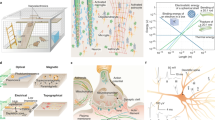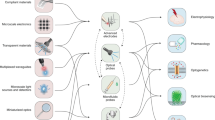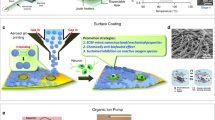Abstract
The study of electronic properties of materials at the nanoscale has unveiled physical laws and generated materials such as nanoparticles, quantum dots, nanodiamonds, nanoelectrodes, and nanoprobes. Independently, large-scale public and private neuroscience programs have been launched to develop methods to measure and manipulate neural circuits in living animals and humans. Here, we review an upcoming field, NanoNeuro, defined as the intersection of nanoscience and neuroscience, that aims to develop nanoscale methods to record and stimulate neuronal activity. Because of their unique physical properties, nanomaterials have intrinsic advantages as biosensors and actuators, and they may be applicable to humans without the need for genetic modifications. Thus, nanoscience could make major methodological contributions to the future of neuroscience and, more generally, to biomedical sciences.
This is a preview of subscription content, access via your institution
Access options
Access Nature and 54 other Nature Portfolio journals
Get Nature+, our best-value online-access subscription
$29.99 / 30 days
cancel any time
Subscribe to this journal
Receive 12 print issues and online access
$259.00 per year
only $21.58 per issue
Buy this article
- Purchase on Springer Link
- Instant access to full article PDF
Prices may be subject to local taxes which are calculated during checkout



Similar content being viewed by others
References
Insel, T. R., Landis, S. C. & Collins, F. S. Research priorities. The NIH BRAIN Initiative. Science 340, 687–688 (2013).
Yuste, R. & Bargmann, C. Toward a Global BRAIN Initiative. Cell 168, 956–959 (2017).
International Brain Initiative.International Brain Initiative: an innovative framework for coordinated global brain research efforts. Neuron 105, 947 (2020).
Yager, T. D., Nickerson, D. A. & Hood, L. E. The Human Genome Project: creating an infrastructure for biology and medicine. Trends Biochem. Sci. 16, 454 (1991).
Helmchen, F. & Konnerth, A. Imaging in neuroscience: a laboratory manual. in Imaging Series (eds. Helmchen, F. & Konnerth, A.) 1084 (Cold Spring Harbor Laboratory Press, 2011).
Ogawa, S., Lee, T. M., Kay, A. R. & Tank, D. W. Brain magnetic resonance imaging with contrast dependent on blood oxygenation. Proc. Natl Acad. Sci. USA 87, 9868–9872 (1990).
Alivisatos, A. P. et al. The Brain Activity Map Project and the challenge of functional connectomics. Neuron 74, 970–974 (2012).
Lozano, A. M. et al. Deep brain stimulation: current challenges and future directions. Nat. Rev. Neurol. 15, 148–160 (2019).
Nagel, G. et al. Channelrhodopsin-2, a directly light-gated cation-selective membrane channel. Proc. Natl Acad. Sci. USA 100, 13940–13945 (2003).
Zayat, L., Baraldo, L. & Etchenique, R. Inorganic caged compounds: uncaging with visible light. CSH Protoc. 2007, db.ip39 (2007).
Kosslyn, S. M. et al. The role of area 17 in visual imagery: convergent evidence from PET and rTMS. Science 284, 167–170 (1999).
Feynman, R. P. There’s plenty of room at the bottom [data storage]. J. Microelectromech. Syst. 1, 60–66 (1992). In this prescient lecture that opened the field, Feynman describes the potential for physics at the nanoscale.
Binnig, G. & Rohrer, H. Scanning tunneling microscopy — from birth to adolescence. Rev. Mod. Phys. 59, 615–625 (1987).
Brus, L. Quantum crystallites and nonlinear optics. Appl. Phys. A 53, 465–474 (1991).
Murthy, S. K. Nanoparticles in modern medicine: state of the art and future challenges. Int. J. Nanomed. 2, 129–141 (2007).
Silva, G. A. Neuroscience nanotechnology: progress, opportunities and challenges. Nat. Rev. Neurosci. 7, 65–74 (2006).
Kotov, N. A. et al. Nanomaterials for neural interfaces. Adv. Mater. 21, 3970–4004 (2009).
Rust, M. J., Bates, M. & Zhuang, X. Sub-diffraction-limit imaging by stochastic optical reconstruction microscopy (STORM). Nat. Methods 3, 793–795 (2006).
Jun, J. J. et al. Fully integrated silicon probes for high-density recording of neural activity. Nature 551, 232–236 (2017). This articles describes the generation of Neuropixel probes, an increasingly popular nanoelectronic device for electrical recordings in vivo.
Lei, N. et al. High-resolution extracellular stimulation of dispersed hippocampal culture with high-density CMOS multielectrode array based on non-Faradaic electrodes. J. Neural Eng. 8, 044003 (2011). The authors describe a large-scale multielectrode array for recording and stimulating neuronal activity.
Segev, E. et al. In Conference on Lasers and Electro-Optics (OSA, 2016).
Robinson, J. T. et al. Vertical nanowire electrode arrays as a scalable platform for intracellular interfacing to neuronal circuits. Nat. Nanotechnol. 7, 180–184 (2012). This article describes the manufacturing of nanopillar arrays and how they’re used to record intracellular activity from cultured neurons.
Alivisatos, A. P. et al. Nanotools for neuroscience and brain activity mapping. ACS Nano 7, 1850–1866 (2013). A review about a series of nanomethods with potential applications in neuroscience.
Seo, D. et al. Wireless recording in the peripheral nervous system with ultrasonic neural dust. Neuron 91, 529–539 (2016).
Choi, J. et al. A 512-pixel, 51-kHz-frame-rate, dual-shank, lens-less, filter-less single photon avalanche diode CMOS neural imaging probe. IEEE J. Solid-State Circuits 54, 2957–2968 (2019).
Shekar, S. et al. A miniaturized multi-clamp CMOS amplifier for intracellular neural recording. Nat. Electron. 2, 343–350 (2019).
Abbott, J. et al. A nanoelectrode array for obtaining intracellular recordings from thousands of connected neurons. Nat. Biomed. Eng. 4, 232–241 (2020).
Jayant, K. et al. Flexible nanopipettes for minimally invasive intracellular electrophysiology in vivo. Cell Rep. 26, 266–278 (2019). The authors introduce quartz nanoelectrodes for stable intracellular recordings in vivo.
Anzar, N., Hasan, R., Tyagi, M., Yadav, N. & Narang, J. Carbon nanotube — a review on synthesis, properties and plethora of applications in the field of biomedical science. Sens. Int. 1, 100003 (2020).
Schuss, Z., Singer, A. & Holcman, D. The narrow escape problem for diffusion in cellular microdomains. Proc. Natl Acad. Sci. USA 104, 16098–16103 (2007).
Holcman, D. & Yuste, R. The new nanophysiology: regulation of ionic flow in neuronal subcompartments. Nat. Rev. Neurosci. 16, 685–692 (2015).
Maier, S. A. Plasmonics: Fundamentals and Applications. (Springer Science & Business Media, 2007).
Bharadwaj, P., Deutsch, B. & Novotny, L. Optical antennas. Adv. Opt. Photonics 1, 438 (2009).
Novotny, L. & van Hulst, N. Antennas for light. Nat. Photonics 5, 83–90 (2011). The authors review applications of plasmonic nanoparticles in diverse fields of science.
Pitarke, J. M., Silkin, V. M., Chulkov, E. V. & Echenique, P. M. Theory of surface plasmons and surface-plasmon polaritons. Rep. Prog. Phys. 70, 1–87 (2007).
Atwater, H. A. The promise of plasmonics. Sci. Am. 17, 56–63 (2007).
Xu, H., Bjerneld, E. J., Käll, M. & Börjesson, L. Spectroscopy of single hemoglobin molecules by surface enhanced Raman scattering. Phys. Rev. Lett. 83, 4357–4360 (1999).
Zhang, R. et al. Chemical mapping of a single molecule by plasmon-enhanced Raman scattering. Nature 498, 82–86 (2013).
Anger, P., Bharadwaj, P. & Novotny, L. Enhancement and quenching of single-molecule fluorescence. Phys. Rev. Lett. 96, 113002 (2006).
Quidant, R. In Gold Nanoparticles for Physics, Chemistry and Biology 483–508 (World Scientific, 2017).
Neubrech, F. et al. Resonant plasmonic and vibrational coupling in a tailored nanoantenna for infrared detection. Phys. Rev. Lett. 101, 157403 (2008).
García-Etxarri, A. & Dionne, J. A. Surface-enhanced circular dichroism spectroscopy mediated by nonchiral nanoantennas. Phys. Rev. B Condens. Matter 87, 235409 (2013).
Kneipp, K. et al. Single molecule detection using surface-enhanced raman scattering (SERS). Phys. Rev. Lett. 78, 1667–1670 (1997).
Nie, S. & Emory, S. R. Probing single molecules and single nanoparticles by surface-enhanced raman scattering. Science 275, 1102–1106 (1997).
Liz-Marzán, L. M. In Colloidal Synthesis of Plasmonic Nanometals 1–13 (Jenny Stanford Publishing, 2020).
Lee, S.-W. et al. Highly sensitive biosensing using arrays of plasmonic Au nanodisks realized by nanoimprint lithography. ACS Nano 5, 897–904 (2011).
Horák, M. et al. Comparative study of plasmonic antennas fabricated by electron beam and focused ion beam lithography. Sci. Rep. 8, 9640 (2018).
Baffou, G., Bordacchini, I., Baldi, A. & Quidant, R. Simple experimental procedures to distinguish photothermal from hot-carrier processes in plasmonics. Light. Sci. Appl. 9, 108 (2020).
Cohen, M. R. & Moiseenkova-Bell, V. Y. Structure of thermally activated TRP channels. Curr. Top. Membr. 74, 181–211 (2014).
Bruchez, M. Jr. Semiconductor nanocrystals as fluorescent biological labels. Science 281, 2013–2016 (1998).
Habib, A. et al. Electro-plasmonic nanoantenna: a nonfluorescent optical probe for ultrasensitive label-free detection of electrophysiological signals. Sci. Adv. 5, eaav9786 (2019).
de Boer, W. D. A. M. et al. Neuronal photoactivation through second-harmonic near-infrared absorption by gold nanoparticles. Light. Sci. Appl. 7, 100 (2018). The authors use plasmonic nanoparticles to activate neurons in vitro and in vivo using two-photon lasers.
García-Etxarri, A. et al. Strong magnetic response of submicron silicon particles in the infrared. Opt. Express 19, 4815–4826 (2011).
Jiang, Y. et al. Heterogeneous silicon mesostructures for lipid-supported bioelectric interfaces. Nat. Mater. 15, 1023–1030 (2016).
Fang, Y. et al. Texturing silicon nanowires for highly localized optical modulation of cellular dynamics. Nano Lett. 18, 4487–4492 (2018).
Chen, H.-T., Taylor, A. J. & Yu, N. A review of metasurfaces: physics and applications. Rep. Prog. Phys. 79, 076401 (2016).
Segev, E. et al. In Conference on Lasers and Electro-Optics JTh4B.2 (Optical Society of America, 2016).
Chan, W. C. & Nie, S. Quantum dot bioconjugates for ultrasensitive nonisotopic detection. Science 281, 2016–2018 (1998).
Larson, D. R. et al. Water-soluble quantum dots for multiphoton fluorescence imaging in vivo. Science 300, 1434–1436 (2003).
Lidke, K., Rieger, B., Jovin, T. & Heintzmann, R. Superresolution by localization of quantum dots using blinking statistics. Opt. Express 13, 7052–7062 (2005).
Ebenstein, Y. et al. Lighting up individual DNA binding proteins with quantum dots. Nano Lett. 9, 1598–1603 (2009).
Efros, A. L. et al. Evaluating the potential of using quantum dots for monitoring electrical signals in neurons. Nat. Nanotechnol. 13, 278–288 (2018). The authors review the potential application of Quantum Dots as reporters of neural activity.
Liu, Y., Lu, Y., Chen, G. & Wang, Q. Recent progress of hybrid optical probes for neural membrane potential imaging. Biotechnol. J. e2000086 (2020).
Park, K., Deutsch, Z., Li, J. J., Oron, D. & Weiss, S. Single molecule quantum-confined Stark effect measurements of semiconductor nanoparticles at room temperature. ACS Nano 6, 10013–10023 (2012).
Bar-Elli, O. et al. Rapid voltage sensing with single nanorods via the quantum confined stark effect. ACS Photonics 5, 2860–2867 (2018).
Marshall, J. D. & Schnitzer, M. J. Optical strategies for sensing neuronal voltage using quantum dots and other semiconductor nanocrystals. ACS Nano 7, 4601–4609 (2013).
Park, K. & Weiss, S. Design rules for membrane-embedded voltage-sensing nanoparticles. Biophys. J. 112, 703–713 (2017).
Caglar, M. et al. All-optical detection of neuronal membrane depolarization in live cells using colloidal quantum dots. Nano Lett. 19, 8539–8549 (2019).
Ludwig, A. et al. Development of lipid-coated semiconductor nanosensors for recording of membrane potential in neurons. ACS Photonics 7, 1141–1152 (2020).
Chen, G. et al. Glutathione-capped quantum dots for plasma membrane labeling and membrane potential imaging. Nano Res. 12, 1321–1326 (2019).
Nag, O. K. et al. Quantum dot–peptide–fullerene bioconjugates for visualization of in vitro and in vivo cellular membrane potential. ACS Nano 11, 5598–5613 (2017).
Karaveli, S. et al. Modulation of nitrogen vacancy charge state and fluorescence in nanodiamonds using electrochemical potential. Proc. Natl Acad. Sci. USA 113, 3938–3943 (2016).
Huang, Y.-A. et al. The effect of fluorescent nanodiamonds on neuronal survival and morphogenesis. Sci. Rep. 4, 6919 (2014).
Barbiero, M. et al. Nanoscale magnetic imaging enabled by nitrogen vacancy centres in nanodiamonds labelled by iron–oxide nanoparticles. Nanoscale 12, 8847–8857 (2020).
Le Sage, D. et al. Optical magnetic imaging of living cells. Nature 496, 486–489 (2013).
Glenn, D. R. et al. Single-cell magnetic imaging using a quantum diamond microscope. Nat. Methods 12, 736–738 (2015).
Haziza, S. et al. Fluorescent nanodiamond tracking reveals intraneuronal transport abnormalities induced by brain-disease-related genetic risk factors. Nat. Nanotechnol. 12, 322–328 (2017).
Barry, J. F. et al. Optical magnetic detection of single-neuron action potentials using quantum defects in diamond. Proc. Natl Acad. Sci. USA 113, 14133–14138 (2016).
Lay, A. et al. Optically robust and biocompatible mechanosensitive upconverting nanoparticles. ACS Cent. Sci. 5, 1211–1222 (2019).
Ma, Y. et al. Mammalian near-infrared image vision through injectable and self-powered retinal nanoantennae. Cell 177, 243–255.e15 (2019).
Liu, J. et al. Near-infrared voltage nanosensors enable real-time imaging of neuronal activities in mice and zebrafish. J. Am. Chem. Soc. 142, 7858–7867 (2020).
Christiansen, M. G., Senko, A. W. & Anikeeva, P. Magnetic strategies for nervous system control. Annu. Rev. Neurosci. 42, 271–293 (2019).
Saurabh, S. et al. Multiplexed modular genetic targeting of quantum dots. ACS Nano 8, 11138–11146 (2014).
Mehlenbacher, R. D., Kolbl, R., Lay, A. & Dionne, J. A. Nanomaterials for in vivo imaging of mechanical forces and electrical fields. Nat. Rev. Mater. 3, 17080 (2018).
Choi, H. S. & Frangioni, J. V. Nanoparticles for biomedical imaging: fundamentals of clinical translation. Mol. Imaging 9, 291–310 (2010).
Acarón Ledesma, H. et al. An atlas of nano-enabled neural interfaces. Nat. Nanotechnol. 14, 645–657 (2019).
Alivisatos, A. P. et al. The brain activity map. Science 339, 1284–1285 (2013).
Park, J. et al. Improved surface functionalization and characterization of membrane-targeted semiconductor voltage nanosensors. J. Phys. Chem. Lett. 10, 3906–3913 (2019).
Park, K. et al. Membrane insertion of — and membrane potential sensing by — semiconductor voltage nanosensors: feasibility demonstration. Sci. Adv. 4, e1601453 (2018).
Nag, O. K. et al. Nanoparticle-mediated visualization and control of cellular membrane potential: strategies, progress, and remaining issues. ACS Nano 14, 2659–2677 (2020). A comprehensive review on the use of nanoparticles for neural sensing and actuation.
Xu, H., Aizpurua, J., Kall, M. & Apell, P. Electromagnetic contributions to single-molecule sensitivity in surface-enhanced raman scattering. Phys. Rev. E Stat. Phys. Plasmas Fluids Relat. Interdiscip. Top. 62, 4318–4324 (2000).
Wu, D. M., García-Etxarri, A., Salleo, A. & Dionne, J. A. Plasmon-enhanced upconversion. J. Phys. Chem. Lett. 5, 4020–4031 (2014).
Hamill, O. P., Marty, A., Neher, E., Sakmann, B. & Sigworth, F. J. Improved patch–clamp techniques for high-resolution current recording from cells and cell-free membrane patches. Pflug. Arch. 391, 85–100 (1981).
Yuste, R. & Katz, L. C. Control of postsynaptic Ca2+ influx in developing neocortex by excitatory and inhibitory neurotransmitters. Neuron 6, 333–344 (1991).
Bando, Y., Sakamoto, M., Kim, S., Ayzenshtat, I. & Yuste, R. Comparative evaluation of genetically encoded voltage indicators. Cell Rep. 26, 802–813.e4 (2019).
Prakash, R. et al. Two-photon optogenetic toolbox for fast inhibition, excitation and bistable modulation. Nat. Methods 9, 1171–1179 (2012).
Fino, E. et al. RuBi-glutamate: two-photon and visible-light photoactivation of neurons and dendritic spines. Front. Neural Circuits 3, 2 (2009).
Carvalho-de-Souza, J. L. et al. Photosensitivity of neurons enabled by cell-targeted gold nanoparticles. Neuron 86, 207–217 (2015). The authors use gold nanoparticles to activate cultured neurons with visible light and conclude that this effect is temperature-mediated.
Garcia-Etxarri, A. Modelling of plasmonic nanoantennas for optical microscopy and surface enhanced spectroscopy, PhD thesis, UPV/EHU (2010).
Acknowledgements
This article originated from group discussions at the DIPC/Columbia University ‘NanoNeuro2020’ meeting, which took place online on 24–25 June 2020. We thank all participants for their input and the Kavli Foundation for funding. R.Y. is supported by NEI (R01EY011787), NINDS (R01NS110422; R34NS116740), NIMH (R01MH115900), NSF (CRCNS 1822550), and the Vannevar Bush Faculty Award (ONR N000142012828). A.G.E. acknowledges support from the Spanish Ministerio de Ciencia e Innovación (PID2019-109905GA-C22) and from E. Jaurlaritza (IT1164-19, KK-2019/00101 and KK-2021/00082).
Author information
Authors and Affiliations
Corresponding authors
Ethics declarations
Competing interests
The authors declare no competing interests.
Additional information
Peer review information Nature Methods thanks Marcel Bruchez, Gabriel Silva, and the other, anonymous, reviewer(s) for their contribution to the peer review of this work. Nina Vogt was the primary editor on this article and managed its editorial process and peer review in collaboration with the rest of the editorial team.
Publisher’s note Springer Nature remains neutral with regard to jurisdictional claims in published maps and institutional affiliations.
Rights and permissions
About this article
Cite this article
Garcia-Etxarri, A., Yuste, R. Time for NanoNeuro. Nat Methods 18, 1287–1293 (2021). https://doi.org/10.1038/s41592-021-01270-9
Received:
Accepted:
Published:
Issue Date:
DOI: https://doi.org/10.1038/s41592-021-01270-9
This article is cited by
-
Augmenting insect olfaction performance through nano-neuromodulation
Nature Nanotechnology (2024)
-
Neuro-nanotechnology: diagnostic and therapeutic nano-based strategies in applied neuroscience
BioMedical Engineering OnLine (2023)



